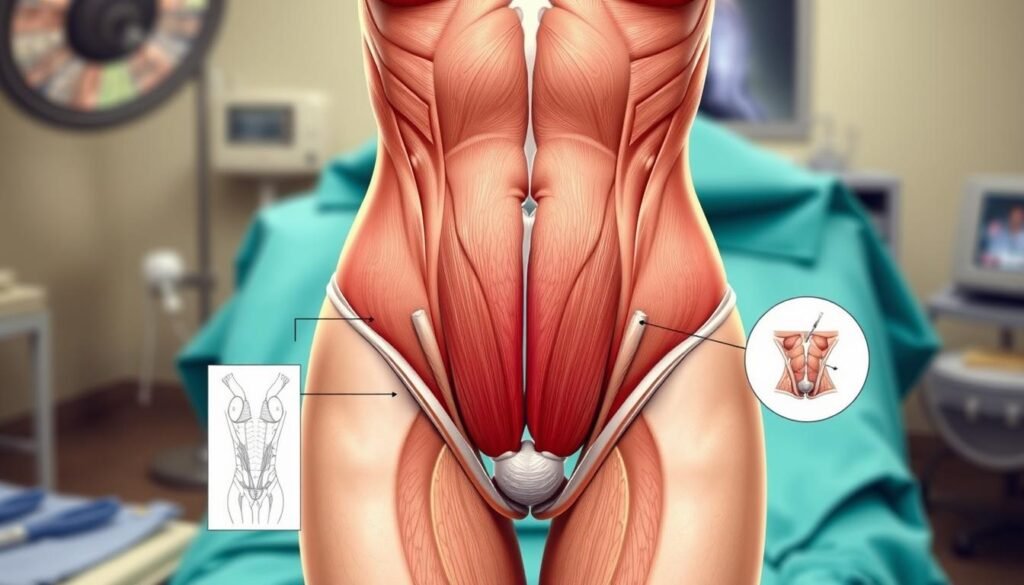Do you have a “mommy pooch” or belly bulge that won’t go away? If yes, you might have diastasis recti. This is when your belly muscles separate. It can make you look and feel bad, cause back pain, and even lead to hernias.
Diastasis recti surgery can fix this. But, insurance often sees it as cosmetic. This means many people pay for it themselves. But, what if you could get insurance to cover it? We’ll look at how to increase your chances of getting your surgery covered.
Key Takeaways
- Diastasis recti is a common condition where the abdominal muscles separate, causing a visible bulge.
- Diastasis recti surgery is often not covered by insurance because it’s considered a cosmetic procedure.
- There are ways to increase the chances of getting diastasis recti surgery covered by insurance.
- Building a strong case with your healthcare provider and insurance company is crucial.
- Appealing denied claims can also help you secure coverage for this necessary procedure.
Understanding Diastasis Recti
Diastasis recti is a common issue, especially for women after pregnancy. It happens when the muscles in the belly split apart. This makes a bulge or gap in the stomach, known as a “mommy pooch.”
What is Diastasis Recti?
Diastasis recti means the muscles in the belly split apart. This often happens during pregnancy as the belly grows. It can also happen in men from heavy lifting or other activities.
Causes and Risk Factors
- Pregnancy, especially in the second or third trimester, is a main cause of diastasis recti.
- Being overweight, poor posture, and certain activities can increase the risk.
- The hormone relaxin during pregnancy can make the muscles separate.
- Diastasis recti can cause back pain, muscle spasms, and back muscle strain.
Up to 60% of women get diastasis recti during or after pregnancy. Knowing the causes helps find the right treatment.

“Treating diastasis recti and hernias together in surgery can reduce the chance of it coming back. It also means no need for mesh, fewer surgeries, and better long-term results.”
If not treated, diastasis recti can lead to hernias, especially in new moms. Surgery can fix the muscle issue and stop more problems.
Medical Necessity for Diastasis Recti Surgery
Diastasis recti might look like a beauty issue at first. But, it can cause big health problems that make surgery needed. People with it often have back pain, pelvic pain, and trouble controlling their bladder. They also struggle with a weak core.
If not treated, it can lead to more serious issues like hernias. These problems show why diastasis recti surgery is a must for insurance to cover.
Severe cases can make it hard to stand up straight and do everyday things. These issues prove the surgery is a medical need, not just for looks. It’s important to show how it affects your health and life to get insurance to pay for it.
Physical Symptoms and Complications
- Lower back pain
- Pelvic pain or discomfort
- Urinary incontinence
- Core instability and weakness
- Increased risk of hernias and other abdominal wall defects
- Poor posture and difficulty with daily tasks
Knowing why diastasis recti surgery is needed can help you talk to your insurance. It shows how it’s important for your health and life quality.

“Diastasis recti is more than just a cosmetic concern – it can lead to serious physical issues that impact daily life. Addressing this condition through surgery may be a medical necessity, not just an elective procedure.”
How to get diastasis recti surgery covered by insurance
Getting insurance to pay for diastasis recti surgery is hard, but you can do it. Work with your doctor to document your condition well. Show why you need the surgery.
First, get a doctor’s diagnosis of diastasis recti. This helps back up your insurance claim. Then, try physical therapy to help your condition. Get a letter from your therapist about how your diastasis recti limits you.
If you have a hernia because of diastasis recti, think about fixing both at once. Insurance might pay more for fixing both problems at once.
Collect all your medical records, doctor letters, and test results. This makes a strong case for why you need the surgery. You might need to keep asking your insurance to reconsider if they say no at first.
Here are the steps to get your surgery approved:
- Get a doctor’s diagnosis
- Do physical therapy and get a therapist’s letter
- Think about fixing the hernia and diastasis recti together
- Collect lots of documents to show you need the surgery
- Keep asking your insurance if they say no
By doing these things and showing you need the surgery, you can increase your chances of getting insurance to pay.

| Statistic | Value |
|---|---|
| Diastasis Recti Repair Surgery Cost | $6,000 – $25,000+ |
| Insurance Coverage for Diastasis Recti Surgery | Often not covered, considered similar to a tummy tuck |
| Hernia Repair Coverage | Insurance usually covers this part of the surgery |
| Diastasis Recti Severity Criteria | Painful abdominal hernia or gap size of 4-5 fingertips or more |
| Diastasis Recti Prevalence | Up to two-thirds of pregnant women, more common in women over 35 |
Getting insurance for diastasis recti surgery takes a lot of work. You need to keep asking, document everything, and show why you need the surgery. With the right steps, you can get the coverage you need.
Advocating for Insurance Coverage
Getting insurance to cover diastasis recti surgery is hard, even if you really need it. You must document your condition, symptoms, and how it affects you. Show what treatments you’ve tried first. This helps you make a good case for coverage.
Building a Strong Case
Start by collecting all your medical records. This includes doctor’s notes, test results, and records of any treatments you’ve tried. Show how bad your diastasis recti is and how it makes everyday life hard, like causing back pain or trouble with your bladder.
Also, get photos of your condition. These pictures can really help show why you need surgery.
Appealing Denied Claims
If your insurance says no, you can appeal. You’ll need to give more evidence and explain why you think you should get surgery. Knowing why they said no is key.
Appealing can be tough, but don’t give up. With a good case and help from experts, you might get coverage. Think about getting help from insurance experts or patient advocates to make your case stronger.
It’s important to fight for your health needs. With a strong case and help with appeals, you can get surgery covered. This way, you can take care of your health and feel better.
Conclusion
Diastasis recti is a common issue that can really affect your health. It can cause pain, make it hard to move, and lower your quality of life. Getting surgery to fix it might be hard, but don’t give up. Keep fighting for the surgery you need.
Learn about what causes diastasis recti and its effects. This will help you explain why you need the surgery. Keep detailed records of your condition. Work with your doctors and go through the appeals if needed. This can help you get the surgery covered by insurance.
To get diastasis recti surgery covered, know why you need it. Fight for your coverage through appeals. Keep trying and document everything. With persistence and a strong case, you can get the surgery you need to feel better.
FAQ
What is diastasis recti?
Diastasis recti is when the muscles in your belly split apart. This makes a visible bulge or gap in your stomach. It’s often called a “mommy pooch”.
What are the causes and risk factors of diastasis recti?
Up to 60% of women get diastasis recti during or after pregnancy. Men can get it too, often from heavy lifting. Being pregnant, overweight, having poor posture, or doing activities that strain your belly muscles can increase your risk.
What are the physical symptoms and complications of diastasis recti?
Diastasis recti can cause lower back pain, pelvic pain, and trouble with your core. If not treated, it can lead to hernias and other problems. In bad cases, it can make it hard to stand up straight or do everyday tasks.
How can I get my diastasis recti surgery covered by insurance?
Getting insurance to pay for diastasis recti surgery is tough but possible. First, work with your doctor to document your condition and its effects. This might mean getting a diagnosis, trying physical therapy, and getting letters from your doctor explaining why you need surgery.
You might also look into combining the surgery with another needed procedure, like a hernia repair. This could help you get insurance to cover it.
What if my insurance provider denies coverage for the diastasis recti surgery?
If insurance says no, you need to speak up for yourself. Keep detailed records of your condition, symptoms, and how it affects you. Trying other treatments first can also help your case.
Appealing the decision might be needed. This means providing more proof and reasons why you need the surgery. It’s hard, but being persistent and having a strong case can help you get coverage.
